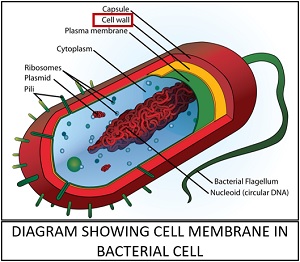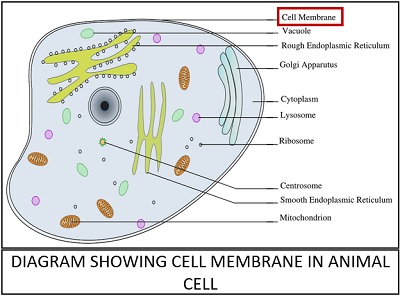The difference between the cell wall and the cell membrane is primarily due to the differences in three factors like composition, function and permeability. The cell wall composition mainly comprises proteins and carbohydrates, whereas a cell or plasma membrane comprises lipids, proteins, and some amount of carbohydrate.
The functional role of the cell wall is to provide protection and rigidity. In contrast, a cell membrane protects the protoplasm and mediates the exchange of materials between a cell and the environment.
A cell wall shows complete permeability towards small molecules, whereas the plasma membrane shows semi permeability that allows water, specific molecules or ions to enter or exit a cell.
Both cell wall and cell membrane are somewhat similar in the way that they are involved in maintaining the cellular physiology of an organism. This post describes the key differences between the cell wall and cell membrane, along with the definition and comparison chart.
Content: Cell Wall Vs Cell Membrane
Comparison Chart
| Properties | Cell wall | Cell membrane |
|---|---|---|
| Existence | It surrounds the cell membrane | It surrounds the inner protoplasm |
| Thickness | Comparatively thicker than the cell membrane (4-20 µm wide) | Thin (5-10 µm wide) |
| Distribution | Found in bacteria, plant and fungal cell | Found in all cells |
| Composition | Composed of proteins and carbohydrates | Composed of lipids, proteins and carbohydrates |
| Permeability | Completely permeable to small protein molecules | Semipermeable to ions and organic molecules |
| Metabolic activity | It is metabolically inactive and non-living in nature | It is metabolically active and living in nature |
| Flexibility | It is rigid and having fixed shape | It is highly flexible |
| Cell receptors | It lacks the presence of cell receptors | It contains the cell surface receptors |
| Visibility | Visible under the light microscope | Visible under the electron microscope |
| Functional role | It is protective in function | It mediates the exchange of materials or ions inside and outside the cell |
Definition of Cell wall
It refers to the outermost covering of most of the bacterial, fungal and plant cells. A plant cell wall primarily possesses cellulose (a most copious polysaccharide found in nature). The cell wall of bacteria comprises a murein peptidoglycan layer (formed by the combination of carbohydrates and amino acids). 
Among bacteria, Mycoplasma is an exception that lacks the cell wall. A fungal cell primarily contains chitin (a nitrogenous polysaccharide). The plant cell-wall mainly comprises the following elements:
- Primary wall possesses cellulose, hemicellulose and pectin.
- Middle lamella primarily contains pectin (a sticky substance), which binds the cell wall to the cell membrane.
- Secondary lamella exists in woody plants, and they form by the deposition of cellulose, hemicellulose, pectin and lignin.
- Plasmodesmata exist as the tiny orifices or channels, which allow the conduction of different materials within the cell.
The cell wall provides structural integrity, cell protection (against turgor pressure and osmotic lysis), storage and communication.
Definition of Cell Membrane
The plasma membrane, cytoplasmic membrane or plasmalemma are the alternative names for the cell membrane. It is common in all living cells, or we can say it is imperative to sustain life. Singer and Nicolson were the two scientists who gave the 3D model and studied the plasma membrane structure through electron microscopy.

The composition of bilayer cell membrane consists of 60-80% of proteins, 20-40% of lipids and 2-10% of carbohydrates. It consists of a phospholipid bilayer membrane, which comprises 50% phospholipid, 2% glycolipids and the remaining sterol.
The phospholipids and glycolipids generally consist of 16-18 carbon-atoms fatty acid chain, which can be saturated or unsaturated. A lipid bilayer membrane also comprises carbohydrates (predominantly glycoproteins), which helps in cell-cell recognition.
The plasma membrane structure contains two significant elements, such as polar or hydrophilic head and two hydrophobic tail. The cholesterol chains are embedded within the fatty-acid tails, and they provide membrane fluidity.
Plasmalemma also contains a group of three membrane proteins like integral, peripheral and lipid-anchored proteins. A plasma membrane performs a vital role in water or ionic conduction, cell signalling and cell adhesion.
Key Differences Between Cell wall and Cell membrane
- A cell wall exists as an envelope surrounding the plasmolemma, whereas a plasmolemma is a protective layer surrounding the inner protoplasm.
- The cell wall consists of a thickness of 4-20 µm or comparatively thicker, and it shows complete permeability. Oppositely, a plasmalemma comprises a thickness of 5-10 µm and shows semi permeability.
- A cell wall is found in the bacterial, plant and fungal cell, whereas plasmolemma is typical in all the cell types.
- The cell wall acts like a non-living and metabolically inactive layer, while the cytoplasmic membrane functions as a living and metabolically active layer.
- Plasmolemma shows a flexibility that was proved by the fluid mosaic model, where the molecules (lipids and proteins) can contract or move. In contrast, the cell wall shows rigidity and possesses a fixed shape.
- One of the distinguishing features is cell surface receptors, which are present in plasmolemma and absent in a cell wall.
Conclusion
Despite many differences, both the cell wall and plasmolemma are the outer coverings, which safeguards the inner protoplasm and internal cell organelles against physical and chemical damage. They can be considered as a shell, which protects the inner body from extreme environmental conditions.